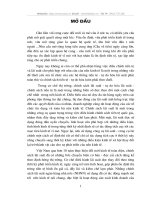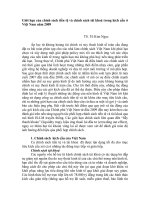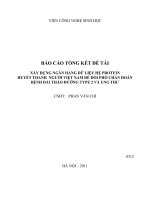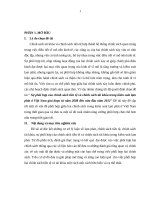Chính sách tiền tệ và tài khóa của Chính phủ Việt Nam để ứng phó với dịch bệnh COVID 19 - Monetary and fiscal policies against COVID 19
Bạn đang xem bản rút gọn của tài liệu. Xem và tải ngay bản đầy đủ của tài liệu tại đây (82.05 KB, 9 trang )
Topic: Analyze relevant economic policies the government has made during COVID -19
outbreak including monetary and fiscal policies. The purpose of each and its impacts on
reviving the economy from the pandemic.
Table of Contents
1. Introduction
2
2. Review of related economic terminologies
2
3. The impacts of Covid -19 on Vietnam’s economy
2
4. Fiscal and Monetary policies of Vietnamese Government against the Covid-19 outbreak
3
4.1. Fiscal policies
3
4.2. Monetary policies3
4.3. Difficulties and Challenges
4
4.4. The impacts on the economy
4
5. Fiscal and monetary policies of other countries and lessons for Vietnam
6. Conclusion
6
REFERENCE LIST
7
5
Topic: Analyze relevant economic policies the government has made during COVID -19
outbreak including monetary and fiscal policies. The purpose of each and its impacts on
reviving the economy from the pandemic.
1. Introduction
At the present time, Covid -19 is not being purely mentioned as an infectious disease or a mild to
moderate respiratory illness, which results in the death of hundreds of thousands of infected
people. In fact, the issue that pertains to Covid-19, and becomes increasingly mindful of most
nations all over the world now, including Vietnam, is the matter of economic downturn sparked
by this pandemic. On that grounds, the essay below is going to measure the economic impacts of
Covid-19 outbreak, then dig deeper into the efficiency of some monetary and fiscal policies
adopted by the Vietnamese government, in an attempt to kick-start the economy from the
pandemic.
2. Review of related economic terminologies
First and foremost, it is necessary to comprehend the notion of policies in both terms of
monetary and fiscal. Monetary policy, according to Amadeo (2020) is generally understood as a
tool that the national banking authorities within one country utilize to manage either directly or
indirectly the amount of money in that economy. However, the spectrum of these policies is not
domestically limited but broadened internationally so that they can achieve the most economic
and employment growth (European Central Bank, 2015). Fiscal policy, in another aspect, is “the
use of government spending and taxation to influence the economy”. Consequently, it is possible
to stimulate sustainable growth along with securing poverty reduction. (Horton & EI-Ganainy,
2020).
3. The impacts of Covid -19 on Vietnam’s economy
Back the situation into Vietnam, one of many countries has to deal with the global spread of
Covid-19, a series of repercussions on the economy is an undeniable fact. According to the
recent report of General Statistics Office in March, never over the past ten years, has the GDP hit
such a modest growth which was only 3,82 percent in the first quarter and far lower than the
previous forecast about the worst scenario (Dat, 2020). Similarly, the prospects of FDI flowing
into Vietnam appeared pretty bleak as this number has decreased by 15.5 percent compared with
the same period. Although in some sectors such as manufacturing, construction, forestry and
fishes, minor development still occurred, it scarcely generated enough employment for the entire
economy.
The Vietnam Chamber of Commerce and Industry has demonstrated recently that, for the first
time, the Vietnamese economy has witnessed the number of enterprises suspending being
considerably higher than the year-on-year figure of new businesses; and just until the end of the
first five months, an approximation of five million people had to remain unemployed and receive
a drop in regular income. This cost, due to Covid-19, was the record-lowest ever during the
current decade (Minh, 2020).
When taking the whole picture into consideration, tourism and hospitality industry have been the
most-gravely affected regions. Because of lockdown orders issued by the government, the
frequency of entertaining activities has dramatically plunged, tourist destinations have drawn an
only restricted number of visitors while the working capital used to keep these businesses
operational was relatively high (PwC, 2020). In short, despite several government’s endeavours
to contain Covid-19 outbreak, this pandemic still threw the Vietnamese economy into turbulence,
and the fact that this economy has been stagnated to some extent is indisputable.
4. Fiscal and Monetary policies of Vietnamese Government against the Covid-19 outbreak
4.1. Fiscal policies
Stemming from the pessimistic outlook of economy and efforts to reassure markets and revitalize
the economy, the Vietnamese government so far has implemented some economic policies,
namely fiscal and monetary. In terms of fiscal policies, one of the major incentives to mention is
the tax structures. On the Decree 41/2020/ND-CP (Decree 41) issued on the eighth of April,
2020, the Vietnamese government has decided to grant a five-month extension for land rents as
well as tax payment including Corporate Income Tax (CIT) and Value-Added Tax (VAT).
These types of incentives have strongly favoured a countless quantity of businesses stretching a
wide scope of different sectors, from agriculture, food processing to manufacturing,
transportation and tourism. According to the Ministry of Finance, on the one hand, these tax
policies will possibly drive more than 700,000 enterprises over the risk of going bankrupt; on the
other hand, will put government’s budget under a heavy financial burden. This challenge is
attributed to the cost of the above method which is VND 180 trillion. Further solutions are also
provided in Directive 11, concerning mainly the support for unemployed workers and the
measures to facilitate local businesses of local authorities (Falak, 2020).
4.2. Monetary policies
In terms of monetary policies, the Vietnamese Central Bank, then other commercial banks such
as HD and AB banks, have announced interest-rate cuts right from the very first days when
Vietnam has had Covid-19 confirmed cases. In detail, the interest-rate cuts are varied from 0.5 to
1 percent. As more businesses were adversely affected by the Covid-19 outbreak, they also will
be given opportunities to obtain partly preferential credit of VND 250 trillion from those
commercial banks (Falak, 2020). Generally, in the context of pandemic’s evolving complexity
and the national tight budget, all of the mentioned policies can be considered as a remarkable
effort of the government.
4.3. Difficulties and Challenges
However, it is necessary for the Vietnamese government to regard the difficulties emerging in the
execution of those policies. Firstly, although each incentive all has obvious target and
orientation, its effectiveness has not been assured yet. This is due to the lack of strict and detail
implementation when policies have processed. Also, the future of pandemic is still unpredictable,
this method, therefore, easily causes the shortage of national budget and creates a condition for
misconduct behaviours, especially tax evasion.
Secondly, in comparison to the scale of businesses hurt by this pandemic, the amount of
expenditure of these support packages was still small. For example, the expectation of fiscal
policies is to allow 98 percent of total enterprises to receive tax measures but in fact, the actual
number of firms benefiting from these policies is negligible (Cung, 2020). Specifically, the
policy has only assisted enterprises that still earned revenue, and had tax obligations. In case the
companies could not maintain production and yield profit, they are not entitled to any tax
support.
Next, in order to reproduce, the tax exemption and deduction time for one business should be at
least one to three years, but this fact sharply contrasts with the length of five months offered by
fiscal incentives (Cung, 2020). Hence, most firms will find these package solutions challenging
to access. Finally, the interest-rate cuts, in spite of being decreased, still seem to be out of reach
of small and medium enterprises. The rate cut actually hardly share the burden of wages for
employees or production expense amongst companies, thus appear ineffective to a significant
number of businesses.
4.4. The impacts on the economy
As a consequence of these above challenging, the impacts of those policies on the economy was
quite marginal. On optimistic aspects, the GDP growth in the first haft of the year has still hit
1.81 percent. Even though according to statistics, this number was the lowest increase amongst
first six-month periods, from 2011 to 2020, it is really an achievement for the whole national
economy because of not suffering negative growth. In the global context, this so-called modest
figure of Vietnam’s GDP is an ambition of most powerful countries (Tap chi tai chinh, 2020).
Additionally, those businesses that can access the package solutions have been able to rebuild
and boost the production. The Prime Minister Nguyen Xuan Phuc has claimed in his recent
meeting with Ministries that he has been already to increase public debt by 2 to 3 percent so that
the economic growth in the last period of the year can be much more tremendous (Thanh, 2020).
Nevertheless, after the very first time of execution, these policies themselves have proved some
disadvantages to the economy. Firstly, in the current situation of Covid-19 along with these
policies, it is estimated that Vietnam has had to spend two to three years to revive the economy,
stated by Mr. Nguyen Tri Dung – the Minister of Planning and Investment. Whereas, since the
pandemic was unprecedented and unpredictable, the lack of urgency and inflexibility with these
incentives will cost Vietnam four to five years recession (Thanh, 2020). Secondly, there is a huge
of enterprises that have not been received financial aid from the government. The bad news is
that they also have no alternative intention to promote and revitalize their businesses. Therefore,
the possibility to reinvigorate the whole economy of these fiscal and monetary policies appears
not positive enough.
5. Fiscal and monetary policies of other countries and lessons for Vietnam
Seeing that Covid-19 is a global pandemic, besides the own efforts and approaches, the
Vietnamese government is entirely possible to analyze policies from other countries so that the
most suitable justifications will be provided to rescue effectively the economy.
In fact, it is clear that the acts of injecting more money into the economy together with applying
interest-rate cuts seem to be practical and useful all over the world. The United States, the
western European countries and likely Japan, neither of them did not pump trillions of dollars
into the economy with the hope that their country could flourish again. However, many
economic professionals have come to decision that there will no longer exist an enough amount
of money for that act, stated by Dr. John Walsh (2020) – an International Business Program
Manager from Rmit University (Vietnam). Therefore, a government that lacks economic
potential like Vietnam, could find it distressing to address the issues just by pumping more
money into the economy.
Furthermore, also according to Dr. John Walsh, since the global financial crisis in 2008, “interest
rates are very low already nearly everywhere in the world”. In other words, this fact sounds a
warning that the application of interest-rate cuts seems to be unproductive.
Finally, Vietnam is entirely possible to gain experience right from their own previous policies.
The challenge in the execution of these policies is extreme but visible, and Vietnam is totally
capable enough of adjusting them to be more appropriate. Promoting public investment to
stimulate economic activities, considering individual regions on a holistic basis, supporting
sectors that generate major impacts on employment, etc., these strategies will boost the economic
growth should they be properly conducted, Dr. John Walsh argued.
6. Conclusion
By and large, the fact that Covid-19 has spread and inflicted economic damage to almost every
nation in the world, including Vietnam, is irrefutable. Although several monetary and fiscal
policies of Vietnam government in responding to this pandemic have minor drawbacks, they are
still one of the drivers that have regulated well the economy in part and made this Southeast Asia
developing country become the lighthouse for others amid coronavirus pandemic. Moreover, the
economy that Vietnam possesses is quite open and attractive. That is to say, as long as Vietnam
can take advantage of their dominance in adopting economic policies, they are able to shape
promising economic future much though Covid-19 outbreak will be.
Reference list
Amadeo, K. (2020). What is monetary policy objectives types and tools. Retrieved from
/>(2015). What is monetary policy. Retrieved from />Horton, M & EI-Ganainy, A. (2020). Fiscal Policy: Taking and Giving Away. Retrieved from
/>
Dat.
(2020).
GDP
growth
hits
10-year
low.
Retrieved
from
/>Minh. (2020). Five million Vietnamese workers lose jobs to Covid-19. Retrieved from
/>(2020). Vietnam attracts USD 12.33 billion in FDI in four months. Retrieved from
/>Tung. (2020). Nearly 31 million workers in Vietnam affected by Covid-19: Report. Retrieved
from
/>
313171.html
(2020). Decree no. 41/2020 / nd-cp on extension of time for tax payment and land rents.
Retrieved from />(2020). COVID-19 and [INDUSTRY] -19 Impact Assessment. Analysis of the Potential Impacts
of
COVID-19
on
Vietnamese
Economy.
Retrieved
from
/>Falak, A. (2020). Vietnam Issues Incentives to Counter COVID-19 Impact. Retrieved from
/>Cung. (2020). Phục hồi kinh tế bằng giải pháp chưa từng có tiền lệ. Retrieved from
/>(2020). Covid-19 policy response notes #2. Vietnam: potential policies responses to the Covid-19
epidemic. Retrieved from
/>(2020). GDP 6 tháng đầu năm: Không để nền kinh tế rơi vào tình trạng tăng trưởng âm.
Retrieved
from
/>
khong-de-nen-kinh-te-roi-vao-tinh-trang-tang-truong-am-324928.html
Thanh. (2020). Chính sách hỗ trợ khó khăn do dịch Covid-19 lần 2: Bao quát toàn diện, đảm bảo
đa mục tiêu. Retrieved from />Le. (2020). Vietnam’s economic outlook after COVID-19. Retrieved from
/>








